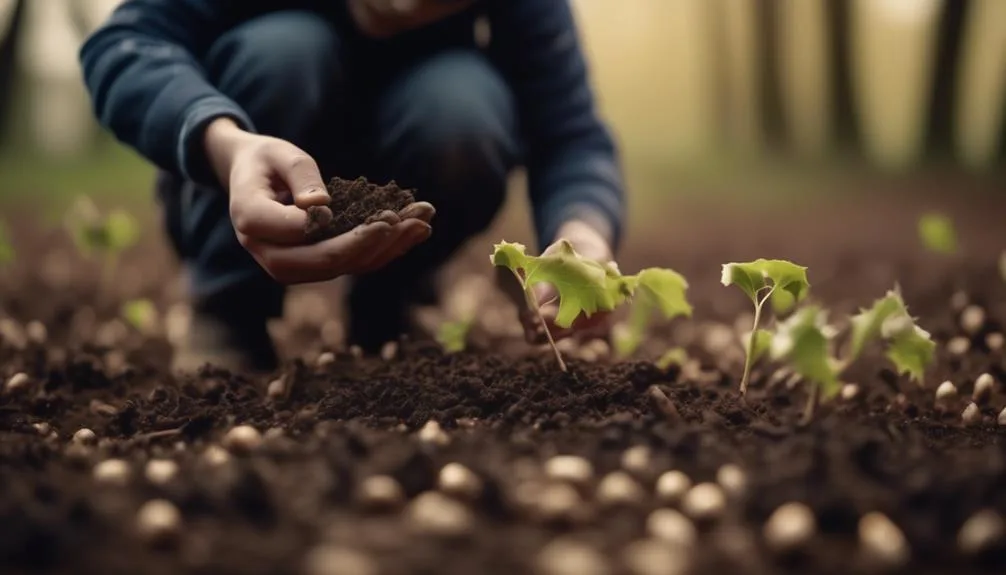Ready to grow sycamore trees from seeds? It's an exciting process that holds the promise of beautiful, towering trees in your landscape.
But how do you turn those tiny seeds into thriving sycamore trees? It involves patience, attention to detail, and a deep understanding of the tree's lifecycle.
Let's explore the steps to nurture those humble seeds into flourishing sycamore trees for your outdoor space.
Selecting Sycamore Tree Seeds
When selecting sycamore tree seeds, look for mature seeds that are plump and have a slightly brown color, as these are more likely to germinate successfully.
Sycamore tree seed sources can include collecting seeds from existing sycamore trees or purchasing them from reputable suppliers.
Optimal conditions for sycamore tree seed germination involve providing a well-draining planting medium, consistent moisture, and a warm environment.
Once you have obtained mature seeds, prepare them for germination by scarifying the seed coat to improve the chances of successful sprouting. This can be done by gently scratching the seed coat with sandpaper or soaking the seeds in warm water for 24 hours.
Preparing the Planting Site
After selecting mature sycamore tree seeds, it's essential to prepare the planting site to ensure optimal conditions for successful germination and growth. Here's what you need to do:
- Soil preparation: Ensure the soil is well-draining to prevent waterlogging, which can hinder seedling development.
- Drainage: Choose a site with good natural drainage to avoid water accumulation that could lead to root rot.
- Sunlight exposure: Pick a location with ample sunlight, as sycamore trees thrive in full sun, which is crucial for their growth and development.
- Spacing: Allow sufficient space between each seedling to prevent competition for resources and ensure they've ample room to grow.
Planting Sycamore Tree Seeds
Want to grow your own sycamore trees from seeds? Start by planting the seeds in a well-prepared soil bed. Ensure the soil is loose, well-draining, and enriched with organic matter.
Sycamore seeds need a period of cold stratification to break dormancy and germinate. You can achieve this by planting the seeds in the fall, allowing them to overwinter naturally, or by simulating winter conditions in the refrigerator for 60-90 days before planting.
Once the seeds have undergone stratification, plant them about 1/4 inch deep in the soil and cover lightly. Water the soil gently to keep it consistently moist but not waterlogged.
Place the planted seeds in a sunny location and wait for the magic of seed germination to occur!
Caring for Sycamore Seedlings
To ensure the healthy growth of your sycamore seedlings, provide them with adequate sunlight and regular watering. Sycamore seedlings require attention to thrive, and proper care is essential for their development. Here are some crucial tips for caring for your sycamore seedlings:
- Watering Techniques: Water the seedlings deeply but infrequently to encourage deep root growth. Avoid overwatering, as it can lead to root rot.
- Soil Nutrients: Use well-draining soil rich in organic matter to provide essential nutrients for the seedlings' growth.
- Sunlight Exposure: Place the seedlings in a location that receives full sunlight for at least 6 hours a day to promote healthy and vigorous growth.
- Protection from Pests: Monitor the seedlings for any signs of pests or diseases and take appropriate measures to protect them.
Transplanting Sycamore Seedlings
Now that your sycamore seedlings have been well cared for and are thriving, it's time to consider the next crucial step: transplanting them to their permanent location.
When transplanting, handle the seedlings carefully to avoid damage to the delicate roots. Choose a site with well-draining soil and ample sunlight.
The optimal timing for transplanting sycamore seedlings is in the early spring or late fall when the weather is mild, and the seedlings are dormant. Before transplanting, water the seedlings thoroughly to ensure they're well-hydrated.
Dig holes that are slightly larger than the root system of the seedlings, and gently place them in the holes. Fill the holes with soil, pressing lightly to remove air pockets.
Water the transplanted seedlings immediately to help them establish in their new location. These transplanting techniques will give your sycamore seedlings the best chance of thriving in their new home.
Conclusion
Now, with the right seeds and proper care, you can look forward to nurturing healthy, mature sycamore trees in your landscape.
Enjoy the process and witnessing these beautiful trees flourish in your surroundings.
Happy planting!

My interest in trees started when I first saw the giant sequoias in Yosemite.
I was a teenager then, and I remember thinking, “I need to learn more about this.”
That moment stuck with me.
A few years later, I went on to study forestry at Michigan Tech.
Since graduating, I’ve worked in a mix of hands-on tree care and community education.
I’ve spent over ten years helping people understand how to plant, maintain, and protect the trees in their neighborhoods.
I don’t see trees as just part of the landscape.
They are living things that make a real difference in our daily lives.
